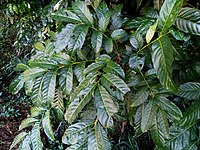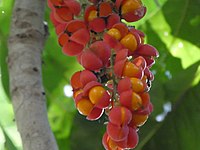Harpullia ramiflora
| Claudie tulipwood | |
|---|---|

| |
| Fruits | |
| Scientific classification | |
| Kingdom: | Plantae |
| Clade: | Tracheophytes |
| Clade: | Angiosperms |
| Clade: | Eudicots |
| Clade: | Rosids |
| Order: | Sapindales |
| Family: | Sapindaceae |
| Genus: | Harpullia |
| Species: | H. ramiflora
|
| Binomial name | |
| Harpullia ramiflora | |

| |
| Synonyms[4] | |
| |
Harpullia ramiflora, commonly known as the Claudie tulipwood or Cape York tulipwood, is a tree in the Sapindaceae family native to north east Queensland, New Guinea and parts of Malesia.
Description
[edit]The Claudie tulipwood is a small tree growing up to 9 m (30 ft) high and a DBH of 15 cm (6 in).[5][6][7] The dark green, glossy, compound leaves have 8 to 12 leaflets, and are quite large (they can reach up to 100 cm (39 in) long including the petiole).[5][6] The ovate to elliptic leaflets are also fairly large, reaching up to 40 by 8.5 cm (16 by 3 in).[5][6]
The inflorescences are initially axillary, later as the leaves fall they become ramiflorous.[7] They are panicles up to 20 cm (8 in) long, and carry numerous flowers about 10–13 mm (0.4–0.5 in) in diameter, with a green caylyx and 4 or 5 white or cream reflexed petals.[5][6][7]
The fruits are bright red-pink, two-valved capsules about 12–18 mm (0.5–0.7 in) long by 18 mm (0.7 in) wide. Each valve contains a single black seed which is almost or completely covered by a bright yellow aril.[5][6][7]
Phenology
[edit]In Australia, flowering occurs from October to July, and fruits ripen from April to November.[6][8]
Taxonomy
[edit]This species was first described in 1877 by the German botanist Ludwig Adolph Timotheus Radlkofer. His paper, titled "Über die Sapindaceen Holländisch-Indiens", was published in 1879 in the work Actes du congrès international de botanistes, d'horticulteurs, de négociants et de fabricants de produits du règne végétal tenu à Amsterdam en 1877.[3][4]
Distribution and habitat
[edit]Harpullia ramiflora is native to the island of Catanduanes in the Philippines, the island of Halmahera and the Aru Islands in the Maluku Islands, New Guinea, and Cape York Peninsula in Australia.[4][7][9] It grows in rainforest and gallery forest.[5][6][10]
In Australia the range of this species was originally from the top of Cape York to near Rossville, but after extensive planting throughout the city of Cairns it has become naturalised in the areas around the city.[10]
Gallery
[edit]-
Glossy foliage
-
Ramiflorous infructescence
-
Mature fruit
-
Unripe fruit
References
[edit]- ^ "Species profile—Harpullia ramiflora". Queensland Department of Environment and Science. Queensland Government. 2022. Retrieved 14 December 2022.
- ^ Marfleet, K. & van Welzen, P.C. (2021). "Harpullia ramiflora". IUCN Red List of Threatened Species. 2021: e.T176152075A177878102. doi:10.2305/IUCN.UK.2021-2.RLTS.T176152075A177878102.en. Retrieved 14 December 2022.
{{cite journal}}: CS1 maint: multiple names: authors list (link) - ^ a b "Harpullia ramiflora". Australian Plant Name Index (APNI). Centre for Plant Biodiversity Research, Australian Government. Retrieved 14 December 2022.
- ^ a b c d "Harpullia ramiflora Radlk". Plants of the World Online. Royal Botanic Gardens, Kew. Retrieved 14 December 2022.
- ^ a b c d e f Reynolds, S.T. (2022). Busby, John R.; Kodela, P.G. (eds.). "Harpullia ramiflora". Flora of Australia. Australian Biological Resources Study, Department of Agriculture, Water and the Environment: Canberra. Retrieved 14 December 2022.
- ^ a b c d e f g Cooper, Wendy; Cooper, William T. (June 2004). Fruits of the Australian Tropical Rainforest. Clifton Hill, Victoria, Australia: Nokomis Editions. p. 492. ISBN 9780958174213.
- ^ a b c d e "Harpullia ramiflora | Flora Malesiana". Flora Malesiana. Retrieved 15 December 2022.
- ^ "Harpullia ramiflora · iNaturalist Australia". iNaturalist. Retrieved 15 December 2022.
- ^ "Search: species: Harpullia ramiflora | Occurrence records | The Australasian Virtual Herbarium". Australasian Virtual Herbarium. Australian Government. Retrieved 15 December 2022.
- ^ a b F.A.Zich; B.P.M.Hyland; T.Whiffen; R.A.Kerrigan (2020). "Harpullia ramiflora". Australian Tropical Rainforest Plants Edition 8 (RFK8). Centre for Australian National Biodiversity Research (CANBR), Australian Government. Retrieved 14 December 2022.
External links
[edit] Data related to Harpullia ramiflora at Wikispecies
Data related to Harpullia ramiflora at Wikispecies Media related to Harpullia ramiflora at Wikimedia Commons
Media related to Harpullia ramiflora at Wikimedia Commons- View a map of historical sightings of this species at the Australasian Virtual Herbarium
- View observations of this species on iNaturalist
- View images of this species on Flickriver





